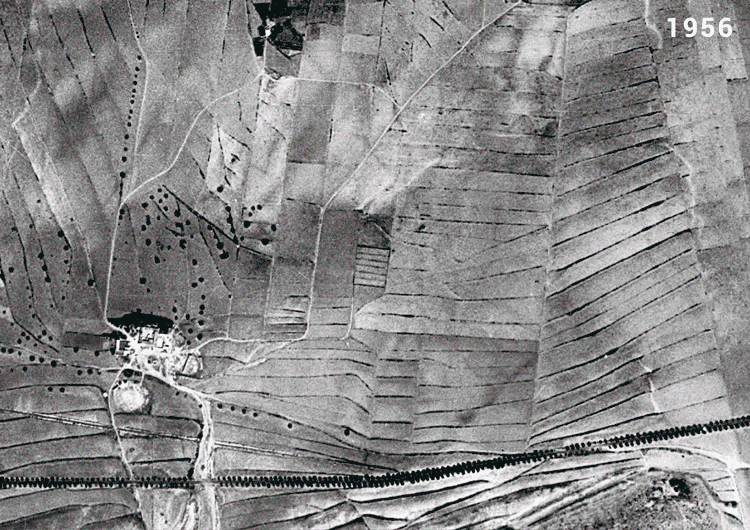An environmental agent finds a pipe that has been left uncovered in the Campo de Cartagena – the Cartagena Field, a region in southeastern Spain. Its content is proofed. It is brine, the result of water desalination. But this brine is also loaded with nitrates, because it resulted from the desalination of water extracted from an aquifer polluted by fertilizers. A high risk mix for water bodies such as the Mar Menor. If nitrates accumulate in them, they can trigger eutrophication, originating the so-called 'green soup'.
Eutrophication. (nom. f.) Process by which nitrates fertilize algae and phytoplankton, causing their uncontrolled reproduction, preventing light from reaching the bottom of the lagoon. The water turns green and the seagrass dies.
It is decided to seal the pipe. A contract is made. Four or five workers arrive at the site with the necessary machinery. A few minutes before starting, a call is received. The manager tells the workers to stop, because the call is from the presidency (of the Confederación Hidrográfica del Segura – Hidrographic Confederation of the Segura Basin, the regional water authority). The operation is cancelled. The environmental agent who found the pipe talks to a colleague who tells him that when he joined the Confederation, the commissioner told him to "forget the issue with the desalination plants". (Environmental agent 1932’s witness statement in the Topillo case, to which DATADISTA has had access.)
What they have discovered is only a minimal glimpse into what is to be found underground. "The issue with the desalination plants" is by then a problem composed of hundreds of illegal installations and a dense network of underground pipelines that discharge into the sewage system or into creeks and from there into the Mar Menor or into aquifers.
On that same year, south of the Campo de Cartagena, local farms undergo one last major transformation. In 2011 old structures completely disappear: terrace work intended for rain fed agriculture, able to retain water in this area of great scarcity. Forested areas are put under cultivation, topography is altered, farming is done downslope avoid water stagnation and potential root rotting.
When the rainy season comes, water flows quickly and freely down the slope towards the Mar Menor, dragging along fertilizer nitrate. Urbanized areas such as Mar de Cristal are rapidly flooded
A huge pipe appears on the side of the highway. No one has seen it installed, no one owns it, no one can be held responsible for it. The Seprona agents who inspect it declare not to have any doubt: it is a channel designed to collect runoff from farms and take it directly to the Mar Menor. (Documents from investigations on the flooding of the Mar de Cristal and Playa Honda developments, to which DATADISTA has had access).
The waters of the Mar Menor turn into a green soup for a few months. The government of the Region of Murcia and the CHS rush to adopt measures to stop discharges into the lagoon.
Gota fría (Cold front).The figures of the catastrophe that happened in south-eastern Spain on the 12th and 13th of September will stay in the collective memory for a long time. Eight dead, about 800 people rescued from inside their flooded vehicles or houses in the region extending from Murcia to Alicante, a deployment without recent precedent of 1,300 soldiers on land, sea and air. Firefighters, red cross, police. The images will remain. Vehicles adrift, people clinging to a tree so as not to be dragged by the current, waterfalls coming out of houses, streets turned into canals; chairs, shelves, boxes, books, private lives improvising a trench along roadsides. Lost crops.
There's an image the cameras haven't captured. Another disaster that has been cooking for decades in the Mar Menor and under the Campo de Cartagena. The monitoring data published by the Autonomous Community (local government) show the worsening of oxygen levels in the lagoon and an increase in chlorophyll since the summer. The heavy rains that fell on September 13th made the situation worse.
This is the story of how intensive irrigation was allowed to harm the Mar Menor, the largest saltwater lagoon in the western Mediterranean, protected by numerous legal provisions and already put under heavy pressure by the runaway development of the real estate and tourism industries. .
A sea of transparent and highly saline waters, refuge for fish, turtles and seahorses. These waters have already been affected by an inflow from the Mediterranean that resulted when the Estacio channel was dredged so that deeper-draught ships could pass through.
How the insistence on promoting a water-based economic sector, despite the lack of the necessary hydrologic conditions, plus the public administrations’ non-compliance with their duties, led to an environmental disaster, charging former politicians, farmers and large irrigation companies with environmental damage and / or falsehood.
Groundwater is overexploited and polluted with nitrates, despite the fact that European regulations mandate its protection, as it constitutes the future supply for local population when the climate crisis worsens and droughts become increasingly long.
The story of an immense civil engineering work that has recently turned 40 years old: the Tagus-Segura transfer, whose current water flow is less than half of what was originally expected and serves to conceal the true origin of most of irrigation: groundwater. .
The non-compliance of the Confederación Hidrográfica del Segura, whose duty it was to draw up a plan to reduce aquifer overexploitation.
-13000 hm³
Estimated reduction in groundwater reserves in the Segura Basin due to overexploitation. Equal to 32.5 years of the maximum flow provided by the Tagus-Segura transfer for irrigation.
1987
Year in which management plans to reduce groundwater abstraction should have started.
Read more
The story of an Administration that has perfect control over the fate of the transfer’s water, through the comunidades de regantes (associations of irrigators), but that does not have any control on the number of wells opened, nor on the volume of extracted water. The actual number of wells is estimated to be double the ones registered, but during drought, the administration itself promoted the drilling of new boreholes, which continued to be used years after the water scarcity period had ended.
All the legal shortcuts devised to regularize intensive irrigation, after allowing its expansion for years without water in sight to justify it.
Read more
How water extraction from nitrate-contaminated aquifers was allowed, releasing that water into the system, despite the knowledge that in order to be used for irrigation, these brackish waters required a desalination process that would then generate a nitrate-loaded discharge. How the wells were drilled inadequately, without isolating their passage through the polluted aquifer layers, thus allowing nitrate pollution to travel into the lower aquifers.
Cross-contamination of aquifers
And how, through the communication channel existing between the Mar Menor and the aquifers, nitrogen-based fertilizers dragged by irrigation runoff and heavy rains, together with desalination plant discharge, loaded the Mar Menor with nitrates.
300.000 tons
of nitrates are estimated to have accumulated in the Campo de Cartagena aquifer, according to the Ministry of the Environment's solution analysis for its zero discharge objective (2018).
Read more
The story of how hundreds of private desalination machines, installed to make the brackish groundwater of aquifers suitable for irrigation, were encouraged and then allowed to proliferate illegally for years, despite knowing that their outflow of brine and nitrates ended up in the Mar Menor and despite the existence - locked in a drawer - of a list containing the location of each well.
Dozens of licenses for the use of desalination plants were granted, on the condition that the discharges were sent to the public canal and a water treatment plant, but that infrastructure was only half-built, contributing to multiplying the damage.
And when, for a few months in 2016, the Mar Menor became a green soup and 80% of the sea grass disappeared, public canals were closed in a rush. It was necessary to send riot police to face the irrigators, who saw how their discharge channel was closed off and how they were suddenly forbidden to draw water from where they had been drawing it for years.
This is the story of a huge botched operation that has resulted in an underground world of immense illegal installations, tunnels and ducts, that continues to grow today. Even the Civil Guard is impressed by the degree of sophistication with which the facilities were concealed.
This is the story of the machine destruction of historic terraces and of how natural topography was modified to make room for larger farms where downslope cultivation favoured the runoff of fertiliser-loaded water towards the Mar Menor.
From the terraces to industrial irrigation
 Read more
Read more
Of who is behind the large-scale farms, how agricultural models have changed and turned the Campo de Cartagena into a huge production machine, of the large debt acquired by farms to achieve this quick growth, of the money that powers this intensive irrigation and of how much it will cost to mitigate its damage.
Polluted leftovers of the Malaya case
And how even the State, when it had to take over one of the large-scale farms, did it on the fringes of the law, contributing to the damage of the Mar Menor. It was the largest property seized in Spain, owned by the creator of Marbella's urban fabric, Juan Antonio Roca, and left in the hands of a bankruptcy administrator until it was sold for much less than estimated, due to the water problems in the region. The company that managed the estate is among those accused in the Topillo case.
Read more
647 millon
Budget foreseen in the plan for zero discharge into the Mar Menor, which will have to be paid for with public funds and which includes the reduction of nitrates in aquifers.
Read more
The environmental organizations ANSE and WWF, along with researchers at the University of Murcia and Alicante have confirmed episodes of general lack of oxygen in the lagoon starting at five meters depth during the last week of September 2019.
Next chapter: The truth about the transfer ››






